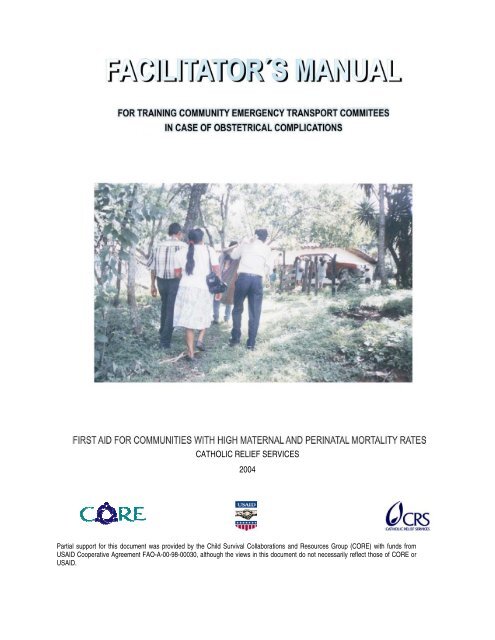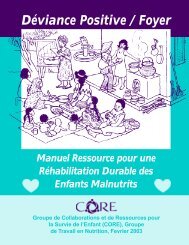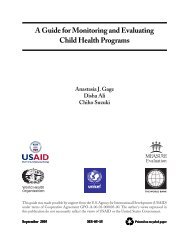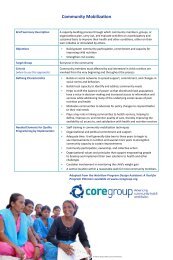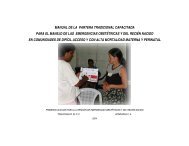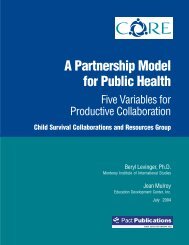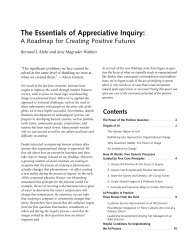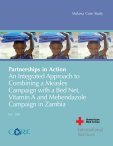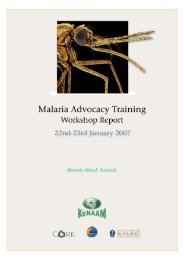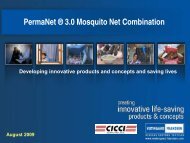Facilitator's Manual for Training Community ... - CORE Group
Facilitator's Manual for Training Community ... - CORE Group
Facilitator's Manual for Training Community ... - CORE Group
You also want an ePaper? Increase the reach of your titles
YUMPU automatically turns print PDFs into web optimized ePapers that Google loves.
CONTENTSN Contents PageI. Introduction 3II. Guidelines <strong>for</strong> Using the <strong>Training</strong> <strong>Manual</strong> 4III. Objectives 5IV. <strong>Training</strong> Program 6V. TopicsTopic 1: Participant introductions, expectations and ground rules <strong>for</strong> the workshopTopic 2: Causes of maternal and infant deaths in the country and in thecommunityTopic 3: Impact of the health situation of women on the health mothers andnewbornsTopic 4: The four reasons <strong>for</strong> delays in receiving quality maternal health careTopic 5: <strong>Community</strong> emergency planTopic 6: Functions of the emergency committeesTopic 7: Definition of advocacy778911151619VI. Annexes 20VII Bibliography 272
I. INTRODUCTIONMaternal mortality is a serious problem throughout the world. More than 500,000 women in poor countries dieannually from pregnancy-related causes. Most of these deaths could be prevented if women have access tobasic obstetrical health services. The geographical isolation of rural populations, coupled with the lack oftransportation, are the main obstacles to access. One alternative <strong>for</strong> addressing this problem is to organize localresources into a community-based evacuation system <strong>for</strong> pregnant or recently-delivered mothers and newbornsin case of an emergency.This manual describes the process <strong>for</strong> training community leaders in the transfer of obstetrical emergencies andthe provision of first aid. It follows a learn-by-doing methodology used in adult education. Its main purpose is toincrease family awareness in order to reduce maternal deaths and to train local leaders in the organization ofcommunity-based emergency transport committees.3
II.GUIDELINES FOR USING THE TRAINING MANUALThese guidelines will help ensure the maximum effectiveness of the training:• Meet with the facilitator team to decide on the topics and methodology <strong>for</strong> the workshop.• The training should be conducted in a climate of trust, creativity, and respect <strong>for</strong> the participants’human rights.• Emphasize aspects that enable participants to improve their ability to detect danger signsassociated with the reproductive cycle and the newborn, define decision-making processes at thehousehold level, set up a community evacuation system, and promote the appropriate use ofinstitutional resources to resolve obstetrical and newborn problems.• Use a participatory methodology that promotes situational reflection and analysis of experiencesrelated to the topics included in the manual.• Using the manual, the workshop will cover five educational topics from the perspective describedbelow:1. Participant introductions, workshop expectations and ground rules: Explains theimportance of introductions in creating a climate of trust and establishing the ground rules<strong>for</strong> the workshop.2. Causes of maternal and infant deaths in the country and in the communities:Describes the magnitude of the problem and the reasons why women and newbornsbecome ill and die.3. Impact of the situation of women on the health of mothers and babies: Describes thechallenges women face in their communities4. The four causes of delays in receiving quality maternal health care: Offersintervention strategies to contribute to improving the quality of maternal care5. <strong>Community</strong>-based emergency plan: Identifies activities or interventions that thecommunity can implement in response to the barriers to access found in this situationalanalysis of the four reasons <strong>for</strong> delays.4
III.OBJECTIVES• To contribute to reducing maternal and perinatal mortality by training <strong>Community</strong> EmergencyTransport Committees <strong>for</strong> Obstetrical and Perinatal Emergencies• To identify the main obstacles to seeking medical care in obstetrical and perinatalemergencies.• To strengthen the organization and participation of individuals, families, and communities infinding solutions to the maternal-infant problems in their communities.• To involve individuals, the family, and the community in the service network so that they canparticipate in solving their own health problems.5
IV.TRAINING PROGRAMTIME OBJECTIVE TOPIC CONTENTS METHODOLOGY RESOURCES30 minutesTo create anatmosphere of trustamong workshopparticipantsTopic 1. Greeting, welcome,and introductionWorkshop objectives andIntroductions activity Expository Markers,or poster board1 hourTo know groupexpectationsmethodologyExpectations and workshopmethodologyCauses of maternal andinfant deaths in thecountry and in thecommunity<strong>Group</strong> exercise: theother-halfDrawings on flipchart45 minutes2 hoursTo reflect onmaternal and infantmortality in thecountry and in thecommunityTo analyze thesituation of mothersand infants in thecommunityTopic 2. Maternal and infantmortalityTopic 3. Health situation ofmothers and infants in thecommunityWhat is the status ofmothers and newborns inthe country-communityImpact of the situation ofwomen’s health on thehealth of mothers andinfantsExerciseWorking groupsSmall groupdiscussions and roleplayPencil, paper, balloons,markersPaper markers, flipchart4 hours8 hoursAfter covering thetopic, theparticipants will beable to identifycontributing factorsin obstacles toaccess toobstetrical andnewborn careDevelopment ofaction plansTopic 4. Delays in receivingquality maternal health careTopic 5. Committee activityplanFour reasons <strong>for</strong> delays inreceiving maternal healthcareActivities that addresseach of the obstaclesidentified in the analysis ofdelays in receiving careLecture, workinggroups, role playsWorking groupsPaper, markers, pencilsPlans2 hours2 hoursDefining the role ofcommunityemergencycommitteesApproaches toadvocacyTopic 6. Functions of theemergency committeesTopic 7. Definition ofadvocacyFunctions of thecommitteesHow to change publicpolicyWorking groupsLecture, workinggroupsPoster paper, markersPoster paper, markers6
V. TOPICSTOPIC 1: INTRODUCTIONS, WORKSHOP EXPECTATIONS AND GROUND RULESObjectives: At the end of the session, the participants will be able to:• Facilitate introductions, integration and a climate of trust in the group• Promote respect <strong>for</strong> the ground rules throughout the workshopMethodology: <strong>Group</strong> exercises/activitiesTime: 30 minutesMaterials: Flipchart paper, markersInstructions:• Invite the participants to <strong>for</strong>m a circle; the facilitators also participate in the exercise.• Post the ground rules in a visible location in the workshop roomBasic concept:Participant introduction and integration creates a climate of trust, encourages respect <strong>for</strong> the ground rules,and clarifies expectations <strong>for</strong> the workshop.7
Guide:Impact of the Situation of Women on Maternal and Infant HealthExercise:Maria’s StoryMaria is a 39 year-old indigenous woman from the village of San José, San Marcos,located 6 kilometers on foot from a health clinic (there is no road) and 6 hours by carfrom the nearest hospital. She has had five children, she cannot read or write, andshe lives in extreme poverty.Maria is eight months pregnant and the TBA has referred her to a hospital to givebirth because she has experienced swelling of the face, hands, and feet since earlymorning. She has not visited the health clinic <strong>for</strong> prenatal care. Her husbandbelieves that “she already has had 5 kids, all with the help of a TBA, and she’s righthere” so he is not planning to let her go to the hospital.As a group, discuss the relevant steps that should be taken in Maria’s case. Whatcan be done? How can Maria and the health personnel improve theircommunication? What can Maria do to be able to get the care she needs? How doesMaria feel about her situation? How do the committee members view women likeMaria?Factors linking the social status of women to maternal mortality:• Society/ culture/ community• Economic• Work• Education• Morbidity• Family/marriage• Fertility• Health• Nutrition10
TOPIC 4: FOUR REASONS FOR DELAYS IN RECEIVING QUALITY MATERNAL HEALTH CAREObjectives: After covering the topic, the participants will be able to:• Analyze the four reasons <strong>for</strong> delays in working groups• Identify examples that have occurred in their communities• Suggest solutions to the causes <strong>for</strong> delaysMethodology: Small group work and discussion, role playTime: 3 hoursMaterials: Background material on the four reasons <strong>for</strong> delaysInstructions:• Form small groups to discuss the materials on: the four reasons <strong>for</strong> delay and whetherthese types of delays occur in their communities.• Examine together the four reasons <strong>for</strong>t delays and suggest solutions to the causes ofdelays• Assign each group a case study on one of the four reasons <strong>for</strong> delays• In the plenary, have each group present a role play on the delay in receiving care and asolutionBasic concepts:• The importance of preventing the four reasons <strong>for</strong> delays <strong>for</strong> maternal and infant mortality.• What the community transport committees can do in case of an obstetrical complication intheir communities.11
Guide:The Four Reasons <strong>for</strong> Delays in Receiving Quality Maternal Health CareNo. PROBLEM SOLUTIONS1. Failure to recognize dangersigns…and symptoms during pregnancy,childbirth, and postpartum• Strengthen knowledge about life-threatening danger signsand symptoms during pregnancy, childbirth, andpostpartum• Educate men and women about when and where to seekcare or help2. Women and their families delay indeciding to seek medical attention• Create operational and financial plans <strong>for</strong> handlingobstetrical emergencies• Strengthen the social status of women• Educate families and communities about the importanceof seeking care without delay3. Women do not reach medical • Create and implement emergency transport plansfacilities in time to receive • Improve transport systemsappropriate care• Improve the system <strong>for</strong> timely patient referral• Make use of maternal homes <strong>for</strong> women about to givebirth4. Women do not receive timely • Provide 24-hour a day obstetrical caremedical care in the hospitals • Improve the quality of care in these facilities• Create national standards of care <strong>for</strong> responding toobstetrical emergencies• Ensure availability of sufficient medical supplies andblood• Improve patient referral systems between communities,health units, maternal health clinics, and hospitals• Ensure the availability of 24-hour support services12
Case Studies of Maternal and Perinatal ComplicationsCASE 1: Women and their families do not recognize dangerous complicationsFAILURE TO RECOGNIZE DANGER SIGNS AND SYMPTOMS DURING PREGNANCY, CHILDBIRTH,AND POSTPARTUM: A 25-year-old woman has a history of three normal births. The fourth time, “the babywas in transverse presentation.” The nurse at the health clinic in Erandique, Lempira, could not treat thepatient because the complication was very serious and beyond her capability and the woman was in criticalcondition.CASE 2: Women and their families delay in deciding to seek medical careMAKING DECISIONS: Fatima, a 27-year-old woman living in a remote village of Camasca, Intibucá, gavebirth to her sixth child, but the placenta was not expelled. One hour later, she was bleeding heavily. Herhusband was not at home and she could not go to the hospital without his permission. Her Uncle Serafíndecided to carry her in a hammock the 15 kilometers to the closest road. As they were nearing the home ofMrs. Suyapa, Fatima died.CASE 3: Women do not reach health care facilities in time to receive appropriate careARRIVED TOO LATE TO RECEIVE APPROPRIATE CARE: A community leader in Vallecitos, Marale, inFrancisco Morazán Department, had a lovely young daughter. His daughter went into labor and hadcontractions <strong>for</strong> almost a whole day, but no one was concerned because they believed this was normal.After several hours, they called the doctor, but he could not relieve her pain. The father finally decided totake his daughter to the hospital. He had trouble finding a driver who could take her. After a long trip, theyfinally reached the hospital, but the baby was dead. The uterus or womb had torn and the girl had to have ahysterectomy. Her husband rejected her because she was now sterile and he found a new wife. The father,with the help of individuals and organizations in the community, has created a fund <strong>for</strong> community transport.All of the community leaders have contributed their own money and organized a committee to take womento the hospital. This community has decided to take action to ensure that this does not happen to anotherwoman. The father says that if he had only known, he would have taken his daughter to the hospital rightaway.13
CASE 4: Women do not receive timely health care in health centersTHEY DO NOT RECEIVE TIMELY CARE IN HEALTH CENTERS:A woman from San Marcos de la Sierra died in a hospital after giving birth to her sixth child. Shehad gone to the hospital but…After they had made a huge ef<strong>for</strong>t to obtain her admittance card, she was admitted.The nurse was called, and she came after she had finished her meal.The husband went to buy surgical gloves and returned; the nurse arrived and examined the woman.The woman began to bleed.After the doctor was called and finally located, he arrived.The husband went to find blood and other supplies, and he was delayed because he was trying to negotiatea lower price with the vendor.The lab technician took the blood given him by the tired husband.The woman continued to bleed.After a change in shift, they filled out the admittance paperwork.The husband signed the consent <strong>for</strong>m <strong>for</strong> the transfusion.By then, so much time had passed that the woman was dead.14
TOPIC 5: COMMUNITY EMERGENCY PLANObjectives: At the end of the session, the participants will be able to:• Develop a community emergency system based on the analysis of the 4 delays inreceiving maternal and infant health care.• Develop a plan to implement the community emergency systemMethodology: Working groupsTime: 8 hoursMaterials: bond paper, markers, plan <strong>for</strong>mat, analysis of the 4 delays in receiving careInstructions: Introduce the topic by giving the participants the following in<strong>for</strong>mation:• The community emergency committee is based on addressing the obstacles to access to maternalhealth services found in the analysis of the 4 delays. This analysis includes delays at four differentmoments: detecting danger signs at home, the decision to seek medical attention outside the home,evacuation of a woman experiencing complications, and clinical care <strong>for</strong> mothers and infants withcomplications.• The detection of danger signs at home is directly related to interventions in the areas of education andhealth, which in many cases will be included in education/ in<strong>for</strong>mation/communication programstargeting the community.• The decision to seek medical help outside the home is related to the woman’s role in the communityand entails education and awareness training to empower women in such decision-making processes.• The availability of transportation to obtain appropriate maternal medical care is a critical factor inaccess. The lessons learned from maternal health projects in Africa, Asia, and Latin America indicatethat community-based emergency transport systems <strong>for</strong> obstetrical complications can be effective inreducing delays in obtaining appropriate medical care. Various local solutions can be used such asestablishing agreements with local transportation unions, buses or trucks, taxis, boats, and cars.• The emergency system also will address limitations found in institutional maternal and perinatal healthcare service provision and will use an advocacy approach to try to influence health policy and resourcesat the local and national levels.• Define a community emergency system• The participants will <strong>for</strong>m working groups by community• Identify the strategies to be included in the action plan• Presentation of the action plans by each community15
TOPIC 6: FUNCTIONS OF THE EMERGENCY COMMITTEES FOR OBSTETRICAL EMERGENCIESObjective: After covering the topic, the participants will be able to identify the specific functions of theemergency committees <strong>for</strong> obstetrical emergencies.Methodology: working groupsTime: 2 hoursMaterials: flipchart paper, markersInstructions:• Divide the participants into two groups• The groups will define the roles of the committee in their community• Make sure the transport committee’s role includes the following:Functions of the Emergency Committee <strong>for</strong> Obstetrical Emergencies:1. To support traditional birth attendants in providing care to pregnant women. The TBA coordinates andactivates the emergency transport system when she considers it necessary.2. To identify pregnant women in the community on a continuous basis.3. To participate in community health activities.CHILDBIRTH PLANThe transport committee, in conjunction with the trained traditional birth attendant and other local leadersand community institutions, can identity the most important measures to take to reduce risks associated withchildbirth in the community. The childbirth plan should include the following:• Identify women with danger signs during pregnancy—bleeding, headaches, swollen face/hands/feet,fever, severe abdominal pain, badly positioned fetus—and orient them regarding where the birth shouldoccur.16
• Identify danger signs in the newborn: hard to rouse, does not nurse, irritable, rapid or weak breathing,the baby is very cold or hot, infected navel, little movement, small or thin. Refer immediately to thehospital.• Identify women with danger signs during and after childbirth—bleeding, the baby is not head down,retention of the placenta, seizures, headache and fever, foul-smelling vaginal discharge—and referthem immediately to the hospital.• Make sure transportation is available to take the pregnant woman to the hospital in case of anycomplication during childbirth.• Previously identify the health facility capable of resolving complications during pregnancy, childbirth,after delivery, and in the newborn.• There should be a community fund, or the mother should have funds set aside, to cover medicalexpenses, fares, fuel, and any other necessities.• Make sure there is someone to care <strong>for</strong> her children, home, and animals while she is in the hospital.• Things the woman should take to the hospital <strong>for</strong> the baby: clothes, diapers, sheets and a hat. For themother: a sweater, toiletries, blankets, sanitary napkins, etc.REMEMBER: <strong>Community</strong> Involvement Saves the Lives of Mothers and ChildrenBasic concepts:• Identify the main intervention strategies that could be included in their communityemergency plans. They must be realistic and it is important not to overlook coordinationwith other organizations <strong>for</strong> best results.• It is impossible to do everything at once. It is important to set priorities, taking intoaccount other initiatives already underway in the community to contribute to reducingmaternal and perinatal mortality.17
Care during Emergency TransportOf the mother:• The mother with a complication should be accompanied during evacuationby a TBA trained in obstetrical emergencies and by a family member.• The mother should be kept covered and warm.• She should be in a com<strong>for</strong>table position and moved as little as possible.Of the baby:• The baby should be transferred in the arms of the mother, father, or anotherrelative.• The baby should be covered to prevent a chill. Low birth-weight babies shouldbe transported using a bag or box.• When the baby is transported in the mother’s arms, she should nurse him or her.If the baby cannot nurse, breast milk should be given with a clean spoon ordropper.• Continuously observe the mother and the baby to provide emotional support.18
TOPIC 7: DEFINITION OF ADVOCACYObjective: After covering the topic, the participants will be able to identify the 8 steps <strong>for</strong> public policyadvocacy; these methods require participatory reflection and analysis.Methodology: working groupsTime: 2 hoursMaterials: flipchart paper, markersInstructions:Explain to the participants that there is a method <strong>for</strong> conducting advocacy and describe it step by step.• Divide the participants into two groups.• Based on the eight steps <strong>for</strong> advocacy, each group should analyze one of the delays and describe howpublic policy could be changed (one group should work on geographical inaccessibility and the other onthe poor quality of care in community health units)• In the plenary, make sure that each group discusses the following:1. Analysis of the problem: A specific action to be taken in response to a particular problem.2. Fine-tuning the proposal: Specify exactly what the goal is. The clearer the proposal, thebetter the chance of success.3. Analysis of the decision-making process: Examine how the decision is made and who youare seeking to influence or motivate.4. Map of power: Identify actors who have some influence with the decision-makers. In otherwords, who are the political and social stakeholders in the decision-making processcontained in the proposal.5. Self-examination: Identify the strengths and weaknesses of the committee as theorganization that will lead the advocacy campaign.6. Advocacy strategy: Define possible ways of influencing decision-makers, neutralizingopponents, acquiring and motivating allies, and influencing the undecided. Define this inlight of who you are trying to influence.7. Activities plan: Activities are the concrete tasks to implement the strategy and achieve theproposed goals.8. Ongoing evaluation: Evaluate each of the advocacy steps (remember that this evaluationwill be done in practice after conducting advocacy)19
VI.ANNEXESANNEX 1DESIGNING AN ADVOCACY INITIATIVE: policy analysis and development of an advocacystrategyMODULE 1 Policy Analysis1.1 Identify issues1.2 Identify actors and institutions with political power1.3 Analyze the political context1.4 Summarize the analysis1.5 Identify options <strong>for</strong> policy changeMODULE2 Define a political advocacy strategy2.1 Select an advocacy issue2.2 Select the target audience(s)2.3 Set advocacy objectives2.4 Identify allies and opponentsMODULE3 Finalize the political advocacy strategy3.1 Select roles3.2 Identify messages3.3 Define advocacy activitiesMODULE4 Make a plan4.1 Develop a logical framework4.2 Create a timeline4.3 Prepare a budget4.4 Plan monitoring and evaluation (this was not done due to lack of time)20
MODULE5 Using the media5.0 Media owners5.1 Develop and send messages5.2 Develop clear, persuasive messages5.3 Send messages strategically5.4 Rein<strong>for</strong>ce messages5.5 Communicate effectively5.6 Negotiate5.7 Use the mass media5.8 Manage risksMODULE6 Facilitation6.1 Strengthen local capacity <strong>for</strong> political advocacy6.2 Work with others6.3 Promote support groups6.4 Facilitation techniques• This content is based on the 8 steps <strong>for</strong> public policy advocacy requiring participatoryreflection and analysis.1. Analysis of the problem: A specific action to be taken in response to a particularproblem.2. Fine-tuning the proposal: Specify exactly what the goal is. The clearer theproposal, the better the chance of success.3. Analysis of the decision-making process: Examine how the decision is made andwho you are seeking to influence or motivate.4. Map of power: Identify actors who have some influence with the decision-makers.In other words, who are the political and social stakeholders associated with thedecision contained in the proposal.5. Self-examination: Identify the strengths and weaknesses of the committee as theorganization that will lead the advocacy campaign.21
6. Advocacy strategy: Define possible ways of influencing decision-makers,neutralizing opponents, acquiring or motivating allies, and influencing theundecided. Define this in light of who you are trying to influence.7. Activities plan: Activities are the concrete tasks to implement the strategy andachieve the proposed goals.8. Ongoing evaluation: After the advocacy campaign, evaluate each of the stepstaken. This is very important in order to have a clear idea of what went well andwhat did not. It is useful <strong>for</strong> refining capabilities and correcting deficiencies withinthe group in the advocacy process.22
ANNEX 223
ANNEX 3Dr. Juan Alexander FloresDirector, CESAMO San MiguelitoDr. Martín VelásquezMinistry of HealthConcepción IntibucáDr. Natanael MartínezMinistry of HealthColomoncagua, IntibucáDr. Helmuth CastroPeace Corps, HondurasLic. Elida Rosa Aguilar de LópezNurse, National Program <strong>for</strong>Comprehensive Women’s HealthCare, Ministry of Health.ACKNOWLEDGMENTSTECHNICAL REVIEWLic. Leticia Areli Juárez MatuteNurse, Ministry of HealthDr. Maria Elena GuevaraAssistant, National Program<strong>for</strong> Comprehensive Women’s Health CareMinistry of HealthLic. Rosa Marlen FloresNurse, National Program <strong>for</strong>Comprehensive Women’s Health CareMinistry of Health.COLLABORATORSLic. Glenda HernándezCRS HondurasLic. Sandra RamosCRS HondurasLic. José AcevedoCRS HondurasSPECIAL COLLABORATORSAssociation of Bordering Municipalities of Intibucá (AMFI)Municipal CorporationColomoncaguaConcepciónCamascaSan AntonioMagdalenaProfessor Alexis Danilo TrejoProfessor Alfredo CardonaLuz Esperanza RamosProfessor Elvira GirónProfessor Francis HernándezName24
Lic. Judith GalindoManagerJalkin Ochoa MendesDriverTECHNICAL TEAM OF THE COMMUNITY-BASED CHILD SURVIVAL PROJECT IN INTUBUCÁCRS SECRETARIA DE SALUD SECRETARIA DE SALUDDr. José Isidro MaradiagaDr. Laura LemusDirector, CESAMOCESAMO, CamascaCamasca, IntibucáCOCEPRADIIDr. Juan Alexander FloresCoordinatorConcepción del CidAsst. CoordinatorNeftalí DíazAsst. CoordinatorErmes Iván CruzAsst. CoordinatorOndina NolascoEducator/Johnny GomezEducatorVilma Gladys DíazEducatorUbaldo RamosEducatorEdgar NolascoEducatorAdolfo DíazEducatorSuyapa GomesEducatorMilton VillanuevaEducatorDolores BarreraEducatorYobany MatuteEducatorJoel MárquezEducatorOscar YánezEducatorDoris YánezEducatorArnulfo PortilloEducatorAlexis ReyesAdministratorHernán Leonel LópezDriverDilsa Marina VásquezCesar Santo DomingoA/E Dunia Rosibel MéndezCESAMO ColomoncaguaA/E Marta Corina ArguetaCESAMO ColomoncaguaA/E Dilvia Xiomara RamosCESAR San MiguelitoA/E Sonia Maribel CoelloCESAR Santa AnaA/E Juan Luis DíazCESAR San MarcosA/E Julio RamosCESAR MagdalenaA/E Hortensia RamosCESAMO San AntonioA/E Juana Dolores BarreraCESAMO San AntonioA/E Dilcia CantareroCesar Santa TeresaA/E Eva GómezCESAMO CamascaA/E Reina VásquezCESAMO CamascaA/E Corina RamosCMI CamascaA/E Gladys Isabel LaínezCMI CamascaA/E Antonio Del CidCESAMO ConcepciónA/E Israel AmayaCESAMO ConcepciónTSA Roberto AguilarCESAMO ConcepciónTSA Javier Santiago VásquezCESAMO ColomoncaguaTSA Oswaldo LópezCESAR MagdalenaA/E Bertilia Mejía ChicasCESAR de GuanigiquilA/E Toribia GámezCESAR JiquinlacaA/E Maribel AmayaCMI CamascaA/E Maria Marcos MejiaCMI CamascaDr. Rina PinedaCESAMO, ColomoncaguaA/E Cesar Agusto ArguetaCMI CamascaA/E Maria Rosa MejiaCMI CamascaA/E Adalinda ZunigaCESAR Santa LucíaT. S. A. Antonio RodríguezCESAMO Camasca25
TECHNICAL TEAM INVOLVED IN THE CHILD SURVIVAL PROJECT, INTIBUCÁ COMMUNITYBASECATHOLIC RELIEF SERVICES(CRS)Lic. Glenda HernándezManager, CS Pilot ProjectDra. Marylena Arita de FuManager CSPIINTIBUCÁ CENTRAL COMMITTEE FOR WATER AND INTEGRATEDDEVELOPMENT PROJECTS (COCEPRADII)Prof. Norma Araceli Coello Eliseo CantareroPresident COCEPRADII EducatorLic. Adela FloresRoney Isidro DíazCoordinatorEducatorDr. Helmuth CastroIndira CardonaCoordinatorEducatorDr. Marvin Arístides Rodríguez Marvin ZunigaCoordinatorEducatorLi c. Mirna NúñezMariana OsorioCoordinatorEducatorJosé María SantosElvira RamosAsst. CoordinatorEducatorMario LagosBerta Lilian CastilloAsst. CoordinatorEducatorMaría Elena LanzaJuan Carlos OrtizAsst. CoordinatorEducatorRuth OrellanaRoberto CastilloAsst. CoordinatorEducatorAstenia MedinaDarwin FloresEducatorEducatorJosé santos LemusMauro Tulio LópezEducatorEducatorSalma DíazSusana ArguetaEducatorEducator26
VII.BIBLIOGRAPHY1. Catholic Relief Service, Propuesta de Parteras en el Marco del Proyecto de SupervivenciaInfantil.2002.2. Catholic Relief Service, In<strong>for</strong>me del Taller de Capacitación para Comités de EmergenciasProyecto de Supervivencia Infantil.2002.3. Encuesta Nacional de Epidemiología y Salud Familiar. ENESF Ministry of Health. 20014. Iniciativa Reducir los “Riesgos del Embarazo” Trabajo con Individuos, Familias yComunidades para mejorar la salud de la madre y el recién nacido.Organizacion Mundialde la Salud.20025. <strong>Manual</strong> de Normas y Procedimientos de Atención Integral a la Mujer. Ministry ofHealth.19996. Investigación de Muerte Materna y de Mujeres de en Edad Reproductiva. IMMER,Ministry of Health.19977. <strong>Manual</strong> de Salud Materno – Perinatal para Promotores Comunitarios. SegundaEdición1998.Centro Latinoamericano de Perinatologia y Desarrollo Humano CLAP-OPS/OMS.19888. Populación Referente Bureau.Por una Maternidad Sin Riesgos. Como superar losObstáculos en la Atención a la Salud Materna.20029. Promoviendo La Calidad del Cuidado del Recién Nacido. CARE199827


